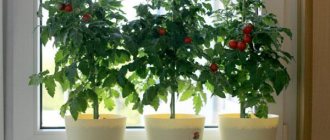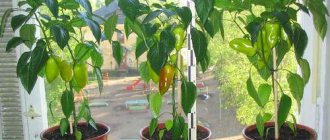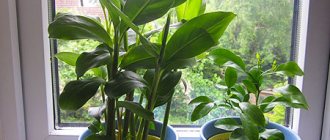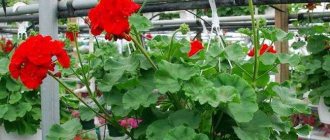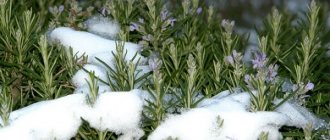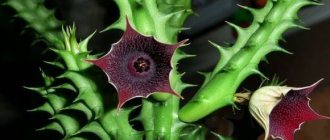Cucumbers are a summer crop, but you still want to enjoy a fresh vegetable in the fall.
And your own, and not bought in a store. To do this, you can grow cucumbers on the windowsill in an ordinary apartment. Dear readers!
For you, we have created communities on social networks in which useful articles and interesting ideas are published several times a day! Subscribe and receive useful content in a convenient format! In this article we will talk about growing at home. Let's figure out which varieties to plant and what nuances exist.
What varieties of cucumbers are suitable for growing on a windowsill?
When choosing a variety for the windowsill, preference should be given to early ripening cucumbers. These must be self-pollinating hybrids, since there are no bees in a regular apartment. And in winter they will not arrive even by chance.
The most suitable plants are those that form compact bushes with a minimum number of vines.
If we talk about specific varieties and hybrids that can be grown at home, then it is worth paying attention to the following varieties: Shchedrik, Room Miracle, Masha F1, Onega F1, Khrustik, Emelya F1, Miracle on the Window F1, At the Pike's Command, Athlete, Balcony, etc.
Choosing a variety
In order for cucumbers not only to produce leaf mass, but also to set fruit, for indoor growing you only need to choose:
- early cucumbers;
- self-pollinating varieties (in winter there are no pollinating insects, especially in the house);
- compact low varieties with small leaves (they take up less space);
- small-fruited varieties (large cucumbers need more nutrients, which is difficult to provide in conditions of limited space in pots).
The cucumber varieties Balcony Miracle, Harmonist, City Cucumber, and Ladies' Man are ideal for planting in pots.
Where is the best place to place cucumbers?
As you know, this vegetable crop loves sunlight and warmth. It is tempting to place containers on a south-facing windowsill. But this will be a mistake, since the window glass will focus the sun's rays, which will lead to burns on the leaves of the plant.
Therefore, it is necessary to keep cucumbers on a southeast or southwest window.
ON A NOTE. Make sure that the cucumber leaves come into contact with the window glass as little as possible. First of all, they are too cold. Secondly, the leaves will burn in the sun.
Ideally, containers with vegetables should be placed half a meter from the window. Ideal - on a warm balcony. If this is not the case, then use stands or a regular table.
Soil and container
First, seedlings are grown. To do this, it is advisable to plant the sprouted seeds in disposable plastic cups. They need to be filled with a special soil mixture, which is sold in any flower shop or supermarket. You can prepare the soil for seedlings yourself. You need to take equal proportions of peat and humus, turf soil and crushed wood waste (for example, sawdust); mix everything well.
About a glass of ash, nitrophoska (2 teaspoons) and urea (1 teaspoon) are added to the bucket volume of the resulting mass. Once again, everything is mixed well and the soil mixture for planting seedlings is ready.
Attention! Before filling the glasses with soil, it is advisable to disinfect them too (rinse with the same weak manganese solution).
You need to make holes in the cups using an awl or a nail so that there is no stagnation of water during watering. Now you need to fill the soil and plant the cucumber seeds at a depth of about 2 cm (the soil needs to be slightly moistened before planting). Now the cups need to be covered with film, you can install glass on top. For the entire period until the seeds germinate, you need to ensure a temperature of +23 degrees (not lower).
What kind of soil do cucumbers need?
Cucumbers on the balcony prefer light, loose and nutritious soil. Therefore, a universal soil for seedlings is quite suitable. If there is such an opportunity, then it is better to choose a pumpkin substrate.
You can also prepare the soil yourself using the following recipe. In a container, mix equal parts compost, garden soil and turf. A little river sand is added to the mixture for looseness, rotted sawdust and ash for nutrition.
The soil cannot be used immediately for its intended purpose. It needs to be disinfected. This can be done by calcining the substrate in the oven or treating it with a liquid fungicide. For example, a solution of Fitosporin or a pale pink solution of potassium permanganate.
Light and nutritious soil for good results
Cucumbers on a windowsill , as well as on a garden bed, in a greenhouse or greenhouse, will not survive in heavy soil without organic matter and minerals. Therefore we have 2 options:
- Buy a bag of prepared substrate for plants of the pumpkin family at a garden store. It doesn't cost much. The need can be calculated based on 5-6 liters per 1 bush. More precisely, according to the volume of your containers for growing cucumbers on the windowsill in winter.
- Make a mixture of equal parts of peat, humus and garden soil. If the soil is not light enough for planting a cucumber on a windowsill, it can be diluted with river sand. It is useful to add a glass of vermiculite and ash to a bucket of the mixture.
The earth is heated at a temperature of 100°C. But this must be done no later than 2 weeks before planting the cucumber on the windowsill. So that the calcined soil comes to life.
Interesting on the topic:
When to plant petunia for seedlings: sowing time, growing from seeds
Jerusalem artichoke - beneficial properties, recipes and applications
Which pot is suitable for growing cucumbers
When grown at home, this vegetable crop has a number of requirements for capacity.
Firstly, volume. The pot must be at least 5 liters per plant. Otherwise, the grown bushes will begin to interfere with each other and compete for nutrients, sunlight, and water.
Secondly, drainage. Cucumbers are “water-breaders”, but they do not tolerate stagnant moisture. Therefore, the container must have a good drainage system.
Best grown in containers or pots with a tray. Excess liquid will drain into the pan. If necessary, the plant will be able to use it.
Requirements for containers for gardening on a window
The path from seed to adult plant can develop according to different scenarios, for example:
- you can plant a seed in a cup with a diameter of 8-10 cm and replant it as the root system grows, increasing its size;
- you can grow cucumbers at home by immediately sowing them in a container in which the plant will live the entire cycle;
- Place the seeds in a peat tablet, wait for germination and transplant into a large container.
The main thing you need to understand is that cucumbers bear fruit on the windowsill in winter:
- a flowerpot, box or bag must hold at least 5 liters of soil, not filled to the very top;
- growing roots need space, which means you will need a container with a wide top;
- The borage drainage system should collect excess liquid.
For beginners, it is better to grow cucumbers on a windowsill in winter in a permanent container. Thus, eliminating the risk of losing a young shoot during transplantation.
Planting cucumbers at home step by step instructions
Now let's move on to sowing the seeds. The entire algorithm will be presented step by step for your convenience.
Step 1. Preparing the seeds. Before sowing, the seeds must be calibrated in a saline solution (a teaspoon per glass of water). The floating grains are thrown away, the rest are dried and soaked in a solution of hydrogen peroxide. This liquid will immediately disinfect the seeds and stimulate their growth.
Step 2. Place drainage at the bottom of the container and pour soil on top.
Step 3. We sow the seeds to a depth of 1 cm. When planting in a common container, maintain a distance of 3 cm. When planting in separate containers, place 2 seeds in a planting hole.
Step 4. Spray with water from a spray bottle. Wrap it in film and cover it with a bag or transparent glass. This creates the greenhouse effect.
Step 5. The containers are placed in a lighted place until shoots appear.
Step 6. Ventilate the plantings regularly and moisten as necessary.
Step 7. When sprouts appear, the cover is removed.
Preparing the soil for planting indoor cucumbers
- The easiest way would be to buy ready-made soil for cucumber seedlings. But it’s safer to prepare the composition yourself: peat + humus + soil from the garden (1/1/4).
- Sterilize the resulting soil. For example, keep it in a water bath or hot oven for an hour. The easiest way is to pour boiling water or a solution of potassium permanganate. This will help prevent the development of fungus and other parasites.
- Wait until it cools down.
How to grow cucumbers at home in winter, features
When growing cucumbers at home, it is necessary to take into account the characteristics of this time of year.
In winter there is little sun, so the main emphasis will have to be on phytolamps.
Also at this time of year, heating radiators operate, which “dry the air,” so you need to carefully monitor the humidity in the room.
The third point is cold and drafts. Do not place containers with cucumbers too close to the window. The glass is very cold. If the leaves come into contact with them, the plant may become sick.
And don’t forget that drafts are detrimental to cucumbers, as is a drop in temperature, even temporary.
Otherwise, growing at this time of year is no different from summer.
Help for germination
For a greenhouse effect during the period when the cucumbers on the windowsill have not yet sprouted, use film or glass. When using tablets , you will have to take care of a small greenhouse. Remember! Peat or coconut substrates tend to dry out quickly.
Light in the window - morning, afternoon and evening
The most difficult and responsible task is to ensure the lighting regime. Especially if you decide to grow vegetables by January . On the cucumber lash, the fruits will ripen in 45-60 days from germination. It depends on what varieties of cucumbers you planted on the windowsill. It turns out that sowing should begin in the last days of October or at the very beginning of November.
We managed to talk to a lighting specialist in the person of amateur gardener Vasily. And he answered our questions.
– Vasily, we decided to eat our own cucumbers on New Year’s holidays. What do you recommend as additional lighting?
- Yes, you can’t do without lighting. LED phytolamps provide good light. Their price ranges from 4-5 hundred to several thousand rubles, but the result and long service life compensate for the costs.
– I would like to know more.
– Lamps for plants using LEDs are: bicolor, multispectrum and full spectrum. The first ones are two-colored, good for seedlings. Multispectrum will help those who want to eat cucumbers in early spring, for example, by March 8th. With the full spectrum, you can get cucumbers on your windowsill for the New Year. If there are no southern windows, you can compensate for this by increasing the power of the electric lighting device.
Getting ready for rapid growth
A properly lit plant will grow quickly. You will soon need some supports or a garter cord. Without a garter, the stem will break. It is necessary to take into account that when growing cucumbers on a windowsill, unlike in a greenhouse, all the tendrils are broken off. Because they slow down growth.
When do cucumbers need lighting and which one is better?
In autumn, winter and early spring, lamps are used for illumination. They are placed 40 cm above the plants. To provide even more light, the lamps are wrapped in reflective foil.
For additional lighting when growing on a windowsill, LED phytolamps are used. Full spectrum is best.
ON A NOTE. Use sheets of regular food foil to create reflective structures to extend daylight hours and provide your cucumbers with more sun.
Basics of agricultural technology
Caring for cucumbers on window sills and beds follows the same principle, but there are also significant differences. At home in winter, the crop grows in a closed container, excess moisture and excess nutrients from the pot have nowhere to go, short daylight hours and low solar activity require additional lighting.
Container and substrate
For growing on a windowsill, the substrate is often purchased at the store. You need to check the acidity of the universal soil - cucumbers do not tolerate increased acidity. Sometimes there is specialized soil on sale for pumpkin crops - it is ideal.
To plant cucumbers, you can prepare the mixture yourself:
- garden soil - 2 parts;
- completely rotted manure – 1;
- lowland peat – 1;
- coarse sand or vermiculite – 1.
All components should be disinfected in the oven or steam for at least half an hour. Then pour in phytosporin. It is not recommended to use a solution of potassium permanganate for disinfection - the concentration is difficult to maintain, and a slight overdose can destroy the culture. If the soil is not treated, young plants can be affected by powdery mildew and other diseases.
To grow cucumbers in winter, it is better to choose a larger pot. If the description does not indicate that the variety can grow in a smaller volume of soil, the container must hold at least 5 liters of substrate. This is not enough for cucumbers, but at home it hardly makes sense to place 10-liter buckets on the windowsill.
The pot for the culture needs to have bottom holes, otherwise the root will sour. Holes can be made with a soldering iron or a hot thick nail.
Drainage in a container with cucumbers on the windowsill is required. You can take:
- expanded clay;
- broken red brick;
- Styrofoam;
- gravel.
When using lightweight material, be sure to ensure that the pot of cucumbers is stable so that it does not fall from the windowsill. For example, put a stone or a heavy metal object on the bottom.
Lighting and temperature
In winter, cucumbers at home lack light and warmth. Already at 17 °C the culture stops development; the most favorable temperature is in the range of 20-25 °C. Intense heat and proximity to heating devices on the windowsill are also unacceptable - at 30 ° C the flowers become sterile and the leaves dry out.
Cucumbers should not stand in drafts during winter, when ventilated, or on window sills with unsealed cracks. Strong temperature changes are unacceptable.
Even if the packaging says: a variety or hybrid tolerates partial shading, this does not mean that the cucumber will develop normally in the back of the room or on a north-facing window sill without additional lighting. In most regions in winter, even the southern direction does not provide the crop with enough light for normal growth and fruiting.
You will have to place a phytolamp next to the cucumbers, or at least a regular one, and add up to 14-16 hours of illumination a day. The distance from the electrical device to the bush is 5-15 cm. You need to check how hot the lamp is to prevent burns to the leaves.
At night, cucumbers should rest. In the dark, the plant processes the nutrients accumulated during the day. If you do not ensure a complete absence of light on the windowsill continuously for at least 6 hours a day, the plants will be depressed and more often affected by infections.
Humidity and watering
Cucumbers are a moisture-loving crop. In winter, when grown on a windowsill, they need to be watered frequently, but the roots should not become soaked or water stagnant.
Air humidity needs to be high. The lashes on the windowsill are tied up; the ends of the shoots usually suffer more than the base of the bush. You can place bowls of water nearby. A good solution is to buy a household humidifier.
Advice! Maintenance will be easier for beginners if you place a wet terry towel on the battery. This immediately solves two problems - the proximity of the window sill and the crop to heating devices in winter, increasing the humidity in the room with cucumbers. It is important to remember to constantly wet the fabric.
You can only use warm water without chlorine. Pumpkin crops generally do not tolerate the presence of chlorine. If in open ground chlorine is not so dangerous - when watering it goes into the soil layers not occupied by the root system of cucumbers, then in the enclosed volume of the pot chlorine has nowhere to go. It accumulates and constantly oppresses the bush.
Feeding
Cucumbers are a fast-growing herbaceous crop. It is impossible to grow them on a windowsill without fertilizers, especially in winter; it is difficult to infuse mullein or bird droppings at home due to the unpleasant odor. It is not recommended to use this fertilizer for potted plants - it can introduce pests or pathogens. Cucumbers especially need potassium, nitrogen and trace elements. Without phosphorus, the crop will not survive, but little of the element is needed.
Beginning gardeners often make the mistake of using all-purpose fertilizers. Nutrients there are not balanced, potassium is often present in compounds with chlorine. The same ammophoska in the ground or greenhouse is relatively harmless, but it is not suitable for cucumbers in pots.
It is better to buy specialized fertilizers for pumpkin crops and use them according to the instructions. There the proportions are correctly selected, instead of chloride it contains potassium sulfate. It is recommended to give microelements by spraying on the leaf.
At low temperatures in winter and insufficient lighting on the windowsill, potassium stops being absorbed. Cucumbers will not grow or bear fruit. The first signs are that on the lower leaves of the crop a dry, as if scorched border appears, the plates become dull.
Fans of organic gardening can feed cucumbers with biological fertilizers on the windowsill. But not prepared independently, but sold in garden centers, based on vermicompost.
Formation
A cucumber bush on a windowsill in winter requires more careful formation than in a garden. The crop should be grown in one stem, tied to the eaves.
Lateral shoots are plucked out as soon as they appear so that they do not draw back nutrients. They do the same with the mustache - on the windowsill they take up a lot of food.
When the crop grows to the desired height, the stem is blinded (the crown is removed). But if the cucumber is strong, healthy, and bears fruit well in winter, you can throw the whip over a rope and allow it to freely fall down to the windowsill.
Pollination
Self-pollinating cucumbers, from a biological point of view, do not exist. They are:
- pollinated by bees (or by hand);
- parthenocarpic - forming fruits without fertilization.
Advice! If a package of cucumbers is marked “self-pollinating,” you need to think about the integrity or competence of the manufacturer. Such a substitution of concepts is forgivable for amateurs, but unacceptable for professionals.
It is recommended to choose parthenocarpic varieties of cucumbers for growing on windowsills in winter. The rest will have to decide how to pollinate the cucumbers by hand. It's not difficult, but it takes time:
- Take a soft brush or cotton swab.
- Carefully pass over all cucumber flowers 2-3 times.
Sometimes a fan is used. This is not the best and unreliable solution - it is not known where the pollen will fly; if the air pressure is strong, the fragile stem of the plant may break.
Features of caring for cucumbers on the windowsill
Now let's talk about the growing conditions that need to be created for vegetables on the windowsill so that they develop and bear fruit.
What kind of water do cucumbers need and watering features?
Water the plants with water at room temperature. It is advisable to defend it first. Do not allow the soil to dry out completely. Do not drain the water from the pan; the cucumbers will use it if necessary.
ON A NOTE. It is necessary to water in the morning.
How, when and what fertilizers to apply
At home, cucumbers also need feeding. For obvious reasons, organic fertilizers cannot be used, so use mineral complexes.
Cucumbers are first fertilized when they have their second true leaf. Then fertilizing is carried out once every 1.5 weeks.
It is recommended to use liquid complexes Florgumat, Zdraven, etc. When the plant blooms, it can be sprayed with a solution of boric acid (2 g per 2 l).
In what cases is pinching necessary?
It is necessary to form cucumber bushes. When the ovaries appear in the first two sinuses, they are removed. This is done because they slow down the formation of fruits.
If the bush weaves strongly, then it is formed into 1 stem. Weakly climbing cucumbers are pinched above the fourth leaf.
Why pick the first cucumber?
Cucumbers are not intended for growing at home. It's quite difficult for culture at first. Therefore, it is customary to pick the first fruits at the ovary stage.
The fact is that when fruiting begins, the plant devotes all its energy to the formation of greens. By removing the first fruits, you will allow the vines to gain strength. Accordingly, further fruiting will go much faster.
Do cucumbers need to be pollinated?
If you grow self-pollinating hybrids, you will not have to pollinate. It is better not to plant other varieties, since pollination is a complex and tedious process.
Garter cucumbers at home
A garter is required for cucumbers growing on a windowsill at home. You can use a variety of supports: build trellises, tie whips to the ceiling, fasten them to wooden pegs, or hook the mustache to the plastic mesh on the windows.
Molding an indoor cucumber bush
To grow an indoor cucumber large and developed, it is customary to form it into 1-2 large vines, so all the shoots that develop to the sides on the central shoot must be pinched.
It is better to tie up already grown bushes. A construction mesh with large cells stretched over the window is suitable for this. The lashes will grow along it, clinging with tendrils. This cucumber curtain will look fresh and spring-like.
Disease Prevention
Unfortunately, cucumbers growing on a windowsill are not protected from pests and diseases.
Most often, plants suffer from aphids and house flies. The most common disease is blackleg.
Green soap, Aktara, Fly eater, etc. will help against insects. There is no escape from blackleg, so infected plants must be removed.
To prevent the development of diseases, it is recommended to use purchased soil, since garden soil is often contaminated. Also, do not neglect the pre-planting treatment of seeds and containers.
We transplant the seedlings to a permanent place
As soon as the seedlings have two leaves, they can be planted in permanent containers.
The container where cucumbers will be grown should be from 5 to 8 liters in volume. These can be ceramic pots, boxes or plastic bags, cut-off and large plastic water bottles. You also need to make holes in the bottom so that water does not stagnate after watering.
The bottom of the container is filled with shards, sea pebbles or small crushed stone, expanded clay (this is drainage). Then the soil mixture is poured, exactly the same as we used for the seedlings, and watered a little with manganese solution. A plant is taken from a plastic cup along with a lump of earth and planted in a prepared container. A few centimeters up to the height of the container should be left free; do not fill the soil up to the very edge. During germination, cucumbers may have exposed roots. In this case, it will be easy to cover them by pouring fresh soil mixture.
Common mistakes
- Cucumbers are overcooled. If you place containers with plants too close to the window, they will be too cold. This applies to winter cultivation of crops.
- The plantings are located on the south side. In winter, placing it on a south-facing window sill will be a good idea, but in warmer seasons, the sun will burn the vines and leaves.
- The harvest is too rare. When grown at home, greens are harvested every 2 days. If this is not done, the whip will stop developing.
- The lower leaves dry out. This is a signal that the room is too hot and dry.
- Growing the “wrong” varieties. For home cultivation, use early self-pollinating hybrids.
Subtleties and cultivation technology
In order for cucumbers to grow and bear fruit well, it is important to adhere to all the subtleties of growing technology. Otherwise, without the proper conditions, the vegetable crop will not bring the desired result.
Placement and temperature conditions
Cucumbers are heat-loving crops that thrive in the garden in summer. When growing them on a windowsill, the container should be in a sunny and warm place. Ideal for them is the south side or a warm balcony.
Important! Window sills facing north or west are not suitable for growing cucumbers. The plant will not bear fruit even with additional lighting.
For full growth and development, the plant should be provided with an optimal temperature within 20-23 °C. Until the seedlings get stronger, the temperature should vary from 23 °C to 27 °C. It is recommended to place a sheet of polystyrene foam on a cold windowsill, and then only place the container with seedlings. If you neglect this advice, the root system will develop more slowly.
Lighting
Summer gives vegetables a lot of light, in winter the sun shines less, and for the plant it is very important. From the beginning of late autumn to early spring, it is necessary to ensure proper supplementary lighting. For this purpose, you can use simple LED lamps.
Seedlings need to be illuminated using plant lamps, extending daylight hours to 12-16 hours
Sowing time
Growing cucumbers at home requires observing the timing of sowing seeds. If you need to harvest the crop by a certain day, you can calculate the planting date based on the ripening dates specified by the manufacturer.
Note! To harvest for the New Year, seeds are usually sown at the end of October. In general, landing can be done on any day.
Growing container
For complete comfort of the root system, it is better to place each plant in 5 liter pots. This size will allow you to maintain the necessary humidity without stagnating water. There should be holes at the bottom of the plastic or wooden container for planting through which excess moisture will escape.
The pot must have drainage
Soil selection and seed preparation
Growing cucumbers on your balcony requires preparing the soil with the necessary nutrients and good air and moisture permeability. For sowing seeds, ready-made universal soil can be purchased in specialized stores. Experienced vegetable growers prepare the soil with their own hands. To do this, they use the top layer of soil from the garden and mix it with the same amount of compost. Wood ash, sand and sawdust are also mixed at half the rate.
Answers to frequently asked questions
What temperature do cucumbers need?
Optimally – not lower than +20 (preferably around 25-26). And remember that the growth of bushes will stop at temperatures below +16.
What air humidity is needed?
Cucumbers do not tolerate dry air, but in winter radiators dry the air. To provide the crop with the required level of air humidity when growing at home, cover the battery with a damp towel, use air humidifiers, and saucers with water.
How to predict the harvest by a certain date?
Count 2 months and get the approximate planting time. If it is important to be on time by a certain day, then plant the seeds at intervals of a week. Then some of the bushes will definitely have greens at the right time.
Do I need to use lamps?
When growing in autumn and winter, the use of phytolamps is mandatory. Use full spectrum LED phytolamps. They should be placed 40 cm above the plants and raised higher as the bushes grow.
Cultivation of seedlings
Stick to the rules
The process of growing cucumbers in winter consists of several stages. By following the rules of each of them, you can get a good harvest.
Preparing the soil and containers
Cucumbers prefer loose soil. The soil mixture can be purchased at the store. It is also prepared at home in this way:
- 4 parts compost;
- 3 parts peat;
- 2 parts of turf land;
- 1 part sawdust.
- 1 matchbox of urea per 10 liters of mixture;
- 2 matchboxes of potassium sulfate and superphosphate for the same amount.
To prevent diseases, the mixture is treated with a solution of potassium permanganate while stirring. Then it is moistened with warm water and placed in vessels, leaving 5 cm at the top empty.
It is better to grow seedlings in cups or pots. They may not be deep, since the root system of cucumbers is superficial. It is worth treating them with hot water (about 60˚C). Drainage is placed at the bottom - stones, broken bricks. Make 3 holes at the bottom. This is done to remove excess moisture so that the roots do not rot.
Seed preparation and planting
If the selected seed is in a shell, it is planted dry. Untreated seeds are soaked in a weak solution of potassium permanganate for 15-20 minutes.
To grow cucumbers at home, you first need to germinate the seeds. To do this, water the ground with hot water. Let it cool down. The seeds are placed on top and covered with a bandage folded in two layers (gauze, cloth). Leave in a warm place, wetting all the time.
After the petioles appear (after about 3-4 days), one grain is planted in each glass. Deepen by 2 cm. The petiole should be directed downwards. All vessels are placed in one box so that their edges protrude. Cover with film.
Seedling care
It is necessary to create optimal conditions under which seedlings will quickly develop and grow. The temperature in the room should be 25˚C. After the shoots appear, the film is removed and placed on a lighted windowsill. The temperature should be lower (about 20˚C) so that the seedlings do not stretch out.
Watering the seedlings is done moderately. If she is provided with artificial lighting, then moisturize her 2 times a day. Without additional light - 1 time per day. Water for irrigation should be settled and have a temperature of 23-25˚C.
To grow high-quality seedlings for cucumbers, you need to feed them 2 times during the winter:
- Fertilizer is applied for the first time 2 weeks after emergence. Take 1 tsp. for 3 liters of water, dose 1 glass per sprout.
- The second time - a week after the previous one. The dressing is prepared as follows: 1 tsp. nitrophoska, 1 tbsp. l. wood ash is diluted in 3 liters of water. Apply 1 cup per plant.
Capacity
Based on capabilities and personal preferences, choose a suitable container. Most often used:
- containers, boxes made of various materials - plastic, wood, metal and others;
- tubs;
- buckets;
- pots and flowerpots;
- PET bottles;
- used food containers.
Mandatory container selection criteria:
- minimum volume – 5 l;
- holes at the bottom to drain excess liquid;
- light shade of the material (to prevent overheating);
- drainage layer of expanded clay, pebbles, sawdust.
Related article:
How to pinch cucumbers
Small forms are not suitable - the root system will suffer from lack of space and rapid drying of the soil inside.
Which seeds to choose
Purchase seed from trusted places. When purchasing, they study care recommendations, sowing dates, check the integrity of the packaging and expiration date. Large and even seeds are selected for planting. The traditional method will help check their suitability. Mix 30 g of table salt in 1 liter of water and immerse the planting material in the solution for 2 hours. During this time, large and heavy seeds sink to the bottom, and light ones remain on the surface. The solution is carefully drained, the suitable seeds are washed with clean water and dried.
Particular attention is paid to the choice of variety. Early ripening, self-pollinating cucumbers are preferred. Both hybrids and simple varieties are used. Some of them:
- Chinese kite;
- Moscow salad f1;
- Marinda f1;
- Lilliputian f1;
- Arbat;
- Athlete;
- Flagship.
Prevention of diseases and pests
Irrigation with cold water, lack of light, and contaminated soil lead to diseases. To avoid diseases and pests, it is recommended:
- Select large seeds for sowing and thoroughly disinfect them.
- Wash the planting container with baking soda in warm water.
- Disinfect the soil with a solution of potassium permanganate.
- Observe the regime of light and heat.
- Water the bushes only with warm and clean water.
- Pinch and shape plants in a timely manner.
- Treat cucumbers with Bordeaux mixture, wood ash solution, and whey.
- Regularly inspect the bushes for signs of disease: dry and yellow leaves, brown spots, white bloom.
If not properly cared for, indoor cucumbers develop powdery mildew. White spots appear on the leaves, which can be removed by spraying with Previkur. Another disease, copperhead, appears as deep brown spots on fruits and leaves. The copperhead cannot be treated; infected bushes and cucumbers are removed.
Whiteflies and aphids are dangerous pests. Miniature white insects reproduce quickly and settle on the inside of the cucumber leaf. Because of them, the bushes dry out and cucumbers lose their taste. A tobacco-based decoction helps get rid of pests.
Selection and preparation of a site
For growing, it is recommended to choose window sills or warm balconies, which are located in the western, eastern or southern part of the apartment. Due to the small proportion of sunlight, northern rooms and balconies without glazing (drafts should not be allowed) are not suitable.
How to prepare the place for placing the form with plantings:
- Pull back the curtains, roll up the blinds, remove all indoor plants from the windowsill.
- Wash the window and disinfect it with an alcohol solution.
- If necessary, insulate and seal cracks in wooden frames.
- Prepare sheets of paper in case of temporary shading to avoid burns to the bush.
Deadlines
To choose the optimal time to sow cucumbers, you need to consider some points:
- growing conditions - on a windowsill, covered balcony or loggia;
- characteristics of the selected variety;
- room area;
- air humidity;
- climatic zone of the region;
- the ability to provide a suitable temperature regime;
- natural lighting and additional lighting with lamps.
Related article:
Secrets of crispy cucumber yield
On average, the plant begins to bear fruit 40-50 days after germination. Approximate sowing dates:
- end of October - first harvest on New Year's Eve;
- January – collection in March;
- February – early May.
It is most rational to sow in the 20th of April - the first ten days of May. This planting period no longer requires additional illumination due to the natural increase in daylight hours.
The use of additional lighting lamps and devices will allow you to plant cucumbers at home throughout the year.
Watering and air humidity
Water for irrigation is settled in advance; it should be slightly warm or at room temperature. Water in the morning at the root or in a tray, on clear sunny days - daily, in cloudy damp weather - every other day.
Twice a day you can spray the leaves with a spray bottle. It is important that the green mass of the stem has time to dry before nightfall.
When central heating is turned on in apartments, the air becomes dry; the following measures are used to increase humidity:
- covering radiators and radiators with wet towels;
- installing a working air humidifier near the plantings;
- put pots of water.
To retain moisture inside the soil, mulching is used - covering the soil with straw, sawdust from soft trees, or sphagnum moss.
Related article:
How to pinch cucumbers
